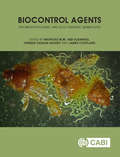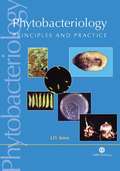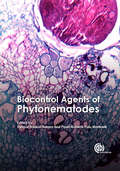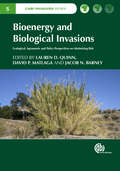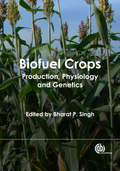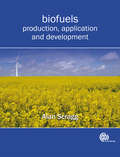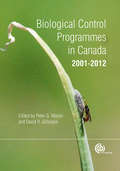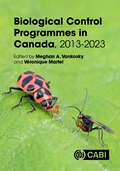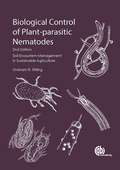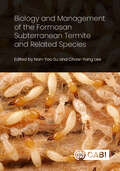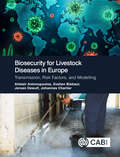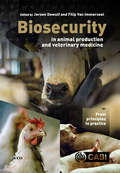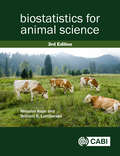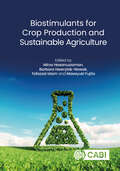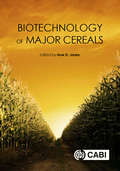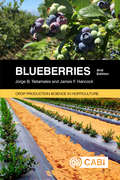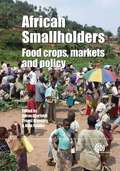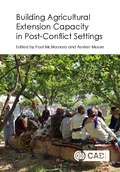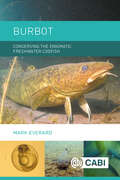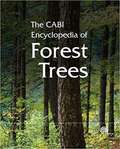- Table View
- List View
Biocontrol Agents
by Tarique Hassan Askary Mahfouz M.M. Abd-Elgawad James CouplandThis book describes entomopathogenic and slug parasitic nematodes as potential biocontrol agents in crop insect and slug pest management. Addressing research on these two nematodes from tropical, subtropical and temperate countries, it covers the new techniques and major developments regarding mass production, formulation, application, commercialization and safety measures. Plans for future strategies to make these beneficial nematodes cost-effective and expand their use by including them in integrated pest management programmes in different agro-ecosystems are also discussed. Biocontrol Agents: Entomopathogenic and Slug Parasitic Nematodes provides a comprehensive review of the topic and is an essential resource for researchers, industry practitioners and advanced students in the fields of biological control and integrated pest management.
Biocontrol Agents of Phytonematodes
by Tarique Hassan Askary K K Fernando Fernando Moussa Moussa Kamal Kishore Chaudhary A H A H Fábio Fábio Pedro Luiz Pedro Luiz Martins Ioannis Ioannis E A E A Christian Cumagun C C Uri Uri M K M K Mahfouz Mahfouz Mohammad Reza Mohammad Reza Masanori Masanori Anwar Bilgrami P R MartinelliHighlighting the use of biocontrol agents as an alternative to chemical pesticides in the management of plant parasitic nematodes, this book reviews the current progress and developments in the field. Tactful and successful exploitation of each biocontrol agent, i.e. nematophagous fungi, parasitic bacteria, predaceous mites, rhizobacteria, mycorrhiza and predaceous nematodes, has been described separately. The contributors are 23 eminent nematologists and their information has been compiled in 19 chapters.
Biocontrol Agents of Phytonematodes
by K K Fernando Fernando Moussa Moussa Kamal Kishore Chaudhary A H A H Fábio Fábio Pedro Luiz Pedro Luiz Martins Ioannis Ioannis E A E A Christian Cumagun C C Uri Uri M K M K Mohammad Reza Mohammad Reza Masanori Masanori Anwar Bilgrami Mahfouz Abd-ElgawadPlant-parasitic nematodes are recognized as one of the limiting factors in crop production all over the world. They impair the quality of crops and cause significant yield losses, seriously threatening global food security. Management of these creatures is a vital aspect of the agricultural process and has often depended upon the use of hazardous chemical nematicides, but the disadvantages of these substances have created interest in searching for alternate safe methods of phytonematode management. This book highlights the use of biocontrol agents as a novel, eco-friendly approach in the management of plant-parasitic nematodes. Besides covering the ecology, diversity and geographical distribution, survival biology and virulence mechanisms of potential biocontrol agents, their limitations have also been described. Reviewing biocontrol agents such as nematophafous fungi, parasitic bacteria, predaceous mites, rhizobacteria, mycorrhiza and predaceous nematodes, the book discusses future research needs in detail. Written in a clear and informative style by eminent nematologists from around the world, this book provides a source of valuable information for researchers, teachers, students of plant nematologym enabling them to plan better strategies for managing plant-parasitic nematodes.
Bioenergy and Biological Invasions
by Rachel Bethke Carol Mallory-Smith Russell Jessup Jacob N Barney Stephen F Enloe Caroline E Ridley Phang Siew Moi Larissa Smith Bryan Endres Lauren D Quinn Lloyd Nackley David MatlagaDespite major international investment in biofuels, the invasive risks associated with these crops are still unknown. A cohesive state-of-the-art review of the invasive potential of bioenergy crops, this book covers the identified risks of invasion, distributions of key crops and policy and management issues. Including a section on developing predictive models, this book also assesses the potential societal impact of bioenergy crops and how to mitigate invasive risks.
Bioenergy and Biological Invasions: Ecological, Agronomic and Policy Perspectives on Minimizing Risk (Plant Science / Horticulture Ser. #5)
by Rachel Bethke Carol Mallory-Smith Russell Jessup Stephen F Enloe Caroline E Ridley Phang Siew Moi Larissa Smith Bryan Endres Lloyd NackleyDespite major international investment in biofuels, the invasive risks associated with these crops are still unknown. A cohesive state-of-the-art review of the invasive potential of bioenergy crops, this book covers the identified risks of invasion, distributions of key crops and policy and management issues. Including a section on developing predictive models, this book also assesses the potential societal impact of bioenergy crops and how to mitigate invasive risks.
Biofuel Crops
by Bharat Singh Ratikanta Maiti Pratik Satya J G Isebrands Surinder S Banga Sujata Bhargava T K Biswas S Wani Steven E Mckeand Toshihiko Yamada Ralph Sims Ismail Dweikat Natalie S Betts Caitlin S Byrt L A Moraes S Hemaiswarya C Dana Nelson Belum V Reddy Jagannath Vishnu Patil Holger Schuhmann Somashekhar Punnuri Gary Stephan Banuelos N K Fageria John H Fike C M Williams Martin Weih Robert B Rummer Rachel A Burton Isabel S Carvalho P Srinivasa Rao Eric J Jokela Donald L Rockwood M Czako Ryan P Viator Peer M Schenk Bill Kovarik Leslie H Groom K C Falk A Moreira Kossonou Guillaume Anzoua Eric Obeng Christopher Q Lan Karaj Singh Dhillon R Raja C Ganesh Kumar A V Umakanth Masazumi Kayama David J Parrish Naser Farrokhi Anna Hale Gary F Peter R Ravikumar Serge Bracconnier Hari P Singh P J Minogue Kurt H Johnsen C Eynck L Marton K MuthukumarappanProviding comprehensive coverage on biofuel crop production and the technological, environmental and resource issues associated with a sustainable biofuel industry, this book is ideal for researchers and industry personnel. Beginning with an introduction to biofuels and the challenges they face, the book then includes detailed coverage on crops of current importance or with high future prospects, including sections on algae, sugar crops and grass, oil and forestry species. The chapters focus on the genetics, breeding, cultivation, harvesting and handling of each crop.
Biofuel Crops: Production, Physiology and Genetics
by Ratikanta Maiti Pratik Satya J G Isebrands Surinder S Banga Sujata Bhargava T K Biswas S Wani Toshihiko Yamada Ralph Sims Ismail Dweikat Natalie S Betts Caitlin S Byrt L A Moraes S Hemaiswarya C Dana Nelson Belum V Reddy Jagannath Vishnu Patil Holger Schuhmann Somashekhar Punnuri Gary Stephan Banuelos N K Fageria John H Fike C M Williams Martin Weih Robert B Rummer Rachel A Burton Isabel S Carvalho P Srinivasa Rao Eric J Jokela Donald L Rockwood M Czako Ryan P Viator Peer M Schenk Bill Kovarik Leslie H Groom K C Falk A Moreira Kossonou Guillaume Anzoua Eric Obeng Christopher Q Lan Karaj Singh Dhillon R Raja C Ganesh Kumar A V Umakanth Masazumi Kayama David J Parrish Naser Farrokhi Anna Hale Gary F Peter R Ravikumar Serge Bracconnier Hari P Singh P J Minogue Kurt H Johnsen C Eynck L Marton K Muthukumarappan Steven E McKeandProviding comprehensive coverage on biofuel crop production and the technological, environmental and resource issues associated with a sustainable biofuel industry, this book is ideal for researchers and industry personnel. Beginning with an introduction to biofuels and the challenges they face, the book then includes detailed coverage on crops of current importance or with high future prospects, including sections on algae, sugar crops and grass, oil and forestry species. The chapters focus on the genetics, breeding, cultivation, harvesting and handling of each crop.
Biofuels
by Alan ScraggProviding the world's growing population with its increasing demands for energy is a major challenge for science, business and society alike. Energy can be generated from many sources, but not all sources are suitable for every application. Much of today's technology has been built on solid, liquid and gaseous fuels derived from fossil sources. However, the supply of these is finite and their combustion produces carbon dioxide, one of the gases responsible for global warming. Therefore, alternative sources of energy are required which are renewable, sustainable and carbon neutral. This textbook explores the production of biofuels as alternatives to fossil fuels, focusing on the technological issues that need to be addressed for any new fuel source. Each type of biofuel currently in production is considered in detail, covering the benefits and problems with production and use and the potential for biological material to provide sufficient energy for the world's population - the principles on which future fuel development are based.
Biological Control Programmes in Canada 2001-2012
by Charles Vincent Rob Bourchier Alec Mcclay Joan Cossentine Tara D Gariepy Rob Mcgregor Peter Mason Guy Boivin Barry Lyons Kevin D Floate Tim Haye Rosemarie De Clerck-Floate Naomi Cappuccino Christian Hébert Gary Peng Jacques Brodeur Howard Thistlewood David R Gillespie Jean J Turgeon Gilles Boiteau Paul Abram John Gavloski Dave Langor Bruce Broadbent Laura Timms Neil Holliday Alan Watson Sue M Boyetchko Martin Erlandson Hector CárcamoCanada is a world leader in biological control research. Reporting the status of biocontrol agents released in Canada over the last decade, this book presents case studies by target pest that evaluate the impact of biocontrol and recommend future priorities. In addition to a new chapter on future targets and an appendix listing established agents, this edition contains information of interest to a global audience, and chapters that address effects of invasive species and climate change.
Biological Control Programmes in Canada 2001-2012
by Charles Vincent Rob Bourchier Joan Cossentine Tara D Gariepy Guy Boivin Barry Lyons Kevin D Floate Tim Haye Rosemarie De Clerck-Floate Naomi Cappuccino Christian Hébert Gary Peng Jacques Brodeur Howard Thistlewood Jean J Turgeon Gilles Boiteau Paul Abram John Gavloski Dave Langor Bruce Broadbent Laura Timms Neil Holliday Alan Watson Sue M Boyetchko Martin Erlandson Hector Cárcamo Alec McClay Rob McGregorCanada is a world leader in biological control research. Reporting the status of biocontrol agents released in Canada over the last decade, this book presents case studies by target pest that evaluate the impact of biocontrol and recommend future priorities. In addition to a new chapter on future targets and an appendix listing established agents, this edition contains information of interest to a global audience, and chapters that address effects of invasive species and climate change.
Biological Control Programmes in Canada, 2013-2023
by Charles Vincent Ian Scott Patrice Bouchard Tim Haye Rosemarie De Clerck-Floate Naomi Cappuccino Jacques Brodeur John Gavloski Martin Erlandson Frédéric Jean Kathleen Ryan Eric Lucas Jon Sweeney Alec McClay Marianne Elliott Christopher Saunders Tim J Dumonceaux Maya Evenden Christine Noronha Anne-Marie Fortier Gene Jones Dr Gary Gibson Marc Kenis Natalia Kirichenko John C. Vederas Paul K. Abram Susanna Acheampong Patrice Audy Jacob V. Basso Tracey Baute Roger L. Becker Koïchi Beltrando Andrew M.R. Bennett Jonathan Bernardo-Santos Suzanne E. Blatt Michael K. Bomford Sébastien Boquel Robert S. Bourchier Susan M. Boyetchko Andrea M. Brauner Luc Brodeur Rosemarije Buitenhuis Erin Bullas-Appleton Juli Carrillo Allan L. Carroll Haley Catton Daniel Cormier Ghislaine Cortat Jenny S. Cory Joan E. Cossentine Isabelle Couture Massimo Cristofaro Carly A. Demers Pauline S. Deschodt Peggy L. Dixon Josée Doyon Shelby V. Dufton François Dumont David J. Ensing Nadir Erbilgin Diana Catalina Fernandez José L. Fernández-Triana Jeffrey G. Fidgen Annabelle Firlej Kevin D. Floate François Fournier Marc Fournier Michelle T. Franklin Annie-Ève Gagnon Bruno Gallant Tara D. Gariepy John F. Gaskin Justin M. Gaudon Eric M. Gerbrandt Pierre Girod Angela E. Gradish Sara Grauby Vojislava Grbic Patrick Häfliger Rebecca H. Hallett Vincent A. Hervet Hariet L. Hinz Tracy K. Hueppelsheuser Corey Hughes Lauréline F. Humair Jeremy Hummel Sarah Jandricic Alida F. Janmaat Rob C. Johns Ian M. Jones Amanda M. Jorgensen Gary J. Judd J. Todd Kabaluk Elizabeth J. Katovich Christopher W. Kirby Jennifer G. Klutsch Didier Labarre Roselyne M. Labbé Geneviève Labrie Simon Lachance Jacques Lasnier Jean-Philippe Légaré Jason Lemay Serena K. Leo Jeffrey L. Littlefield Felix Longpré Marlee-Ann E. Lyle Jesse L. MacDonald Maggie MacDonald Chris J. MacQuarrie Francesca Marini Valerie Marshall Véronique Martel Cara McCreary Michael J. McTavish Jacob H. Miall Val Miller Chandra E. Moffat Debra L. Moreau Boyd A. Mori Benoit Morin Tyler D. Nelson Owen O. Olfert Jennifer K. Otani Emily Owens Jean-Philippe Parent Carolyn K. Parsons Erica E. Pate Cyrane Pouët Caroline Provost Justin M. Renkema Tamara Richardson Sabrina Rondeau Albert Remus Rosana Lucas E. Roscoe Krista Ryall Mark Schwarzländer Cynthia Scott-Dupree Simon Francis Shamoun Jade Sherwood Dylan M. Sjolie Timothy Skuse Jocelyn Smith Sandy M. Smith Juliana J. Soroka Michael Stastny Sonja Stutz Ashley Summerfield Ivo Toševski Amanda P. Tracey Susan C. Turner Willem G. Herk Kate Van Rooyen Udari M. Wanigasekara Philip S.R. Weyl Hester E. Williams Jonathon L. Williams Warren H. WongBiological control is an important component of integrated and ecological pest management programmes. Its importance continues to increase as plant protection is challenged with climate change, invasive species, pesticide resistance, de-registration of pesticide active ingredients, and increasing consumer demands for sustainably produced food and fibre. Biological control is highly compatible with organic cropping systems and evolving pest management frameworks, including biovigilance. Canada continues to be a world leader in biological control research, development of biological control policy, and implementation of biological control programmes. This is the sixth volume of a series of books reporting on the status of biological control research and on biological control programmes employed in Canada. This volume features 58 case study chapters that describe the research and progress in implementation of biological control for pests including insects, mites, weeds, and plant pathogens. Topics important to biological control, including policy, emerging technologies, biological control in urban landscapes and future targets for biological control are reviewed. Although the volume focusses on the Canadian biological control experience, the chapters will be of interest to a global audience of researchers and students of biological control, risk assessment, ecology, and pest management. This book Offers a detailed analysis of the state-of-the-art of biological control in Canada. Explains how biological control research is responding to challenges including climate change and invasive alien species. Gives insights in effective risk assessment and pest management. It is a valuable resource for students and researchers of pest management and biological control, and for practitioners and policy-makers needing analysis of the practical implications of using this approach.
Biological Control of Plant-parasitic Nematodes
by Graham StirlingPlant-parasitic nematodes are one of multiple causes of soil-related sub-optimal crop performance. This book integrates soil health and sustainable agriculture with nematode ecology and suppressive services provided by the soil food web to provide holistic solutions. Biological control is an important component of all nematode management programmes, and with a particular focus on integrated soil biology management, this book describes tools available to farmers to enhance the activity of natural enemies, and utilize soil biological processes to reduce losses from nematodes.
Biological Control of Plant-parasitic Nematodes: Soil Ecosystem Management in Sustainable Agriculture
by Graham StirlingPlant-parasitic nematodes are one of multiple causes of soil-related sub-optimal crop performance. This book integrates soil health and sustainable agriculture with nematode ecology and suppressive services provided by the soil food web to provide holistic solutions. Biological control is an important component of all nematode management programmes, and with a particular focus on integrated soil biology management, this book describes tools available to farmers to enhance the activity of natural enemies, and utilize soil biological processes to reduce losses from nematodes.
Biology and Management of the Formosan Subterranean Termite and Related Species
by Nathan Lo Qian Sun Thomas Chouvenc J. Kenneth Grace Claudia Husseneder Shuji Itakura Hou-Feng Li Kok-Boon Neoh Wakako Ohmura Faith M. Oi Rudolf H. Scheffrahn Gaku Tokuda Edward L. Vargo Chia-Chien Wu Koichi YamamotoThe Formosan subterranean termite, Coptotermes formosanus, is the most destructive and invasive termite species globally. It is also the only termite species listed in the world's 100 worst invasive alien species of the Global Invasive Species Database. Annually, its infestation costs more than $4 billion in control and damage repairs in the USA alone. This book is the first comprehensive resource drawing on all the literature on C. formosanus since Tokuichi Shiraki first described the species in 1909. The book covers the worldwide distribution of this species, its biogeography, and how it has dispersed from its native range in southern China and Taiwan to different parts of the world. It describes its present taxonomic status and discusses the species' biology, ecology, foraging behavior, physiology, chemical ecology and its association with symbionts. From a practical standpoint, the authors address all of the various management options for this species, such as baits, soil termiticides, wood preservatives, inspection and detection technologies, and Integrated Pest Management (IPM) approaches. Lastly, there are chapters dedicated to another important destructive species, Coptotermes gestroi (the Asian subterranean termite), and the recently discovered C. formosanus/C. gestroi hybrids. This important book is an essential and valuable reference for researchers, graduate students, pest management professionals, chemical manufacturer personnel, building and property managers, and others. It provides readers with a comprehensive understanding of the biology and management of the Formosan subterranean termite and the Asian subterranean termite.
Biosecurity for Livestock Diseases in Europe: Transmission, Risk Factors, and Modelling
by Jeroen Dewulf Dr Alistair Antonopoulos Evelien Biebaut Johannes CharlierBiosecurity practices can help prevent the introduction and spread of disease, promoting better animal health and welfare, human health, food safety, and the economic benefits of livestock production. Stemming from a joint initiative between the Biosecure project which brought together 17 partners across 12 European countries, and DISCONTOOLS, the research gap database in animal health, this book provides valuable background information which can help to better understand and prioritize biosecurity measures. Driven by an evidence-based and cost-effective approach to biosecurity, it is divided into two sections covering endemic diseases typically present within most countries, and epidemic diseases with the potential for large scale outbreaks. Through a series of disease entries, it: - introduces the diseases of most relevance for the European context; - reviews our current understanding of biosecurity throughout the livestock production chain, and across the principal terrestrial animal species farmed within Europe: poultry, swine, cattle, and small ruminants; - covers the prevalence, risk factors, transmission routes, current control measures and biosecurity, and data for transmission modelling for each disease. By summarizing current knowledge on a range of diseases, this book forms both a useful resource for researchers and professionals in animal disease prevention, and a starting off point for identifying information gaps and requirements for future research.
Biosecurity in Animal Production and Veterinary Medicine: From principles to practice
by Jeroen Dewulf Filip Van ImmerseelGlobally, the way the animal production industry copes with infectious diseases is changing. The (excessive) use of antimicrobials is under debate and it is becoming standard practice to implement thorough biosecurity plans on farms to prevent the entry and spread of pathogenic micro-organisms. Not only in farm animal production, but also in facilities where companion animals are kept, including in veterinary practices and clinics, awareness of the beneficial implications of a good biosecurity plan has raised. The book Biosecurity in Animal Production and Veterinary Medicine is the first compilation of both fundamental aspects of biosecurity practices, and specific and practical information on the application of the biosecurity measures in different animal production and animal housing settings. The book starts with a general introductory chapter on the epidemiology of infectious diseases, followed by a chapter explaining the general principles of biosecurity. Specific topics of biosecurity, including rodent and insect control, cleaning and disinfection, hygiene and decontamination of feed, drinking water and air, and measuring the biosecurity status of farms, are detailed in dedicated chapters. Explanations on the relevance of the implementation of biosecurity plans in order to improve animal health and performance and reduce antimicrobial usage are described, and a chapter on ways to motivate farmers to implement a biosecurity plan has been included. Practical chapters deal with biosecurity in the poultry, pig and cattle industry, horse facilities, dog kennels, veterinary practices and clinics and laboratory animal facilities. The book is a practical guide that can be used by farm and animal facility managers, consultants, veterinarians, animal caretakers, and people with an interest in prevention of diseases in animals. Academics and students will benefit from the book because it contains all relevant information on animal biosecurity.
Biostatistics for Animal Science, 3rd Edition
by Miroslav Kaps William R. LambersonDesigned to cover techniques for analysis of data in the animal sciences, this popular textbook provides an overview of the basic principles of statistics enabling the subsequent applications to be carried out with familiarity and understanding. Each chapter begins by introducing a problem with practical questions, followed by a brief theoretical background. Most topics are followed up with numerical examples to illustrate the methods described using data-sets from animal sciences and related fields. The same examples are then solved using the SAS software package. Key features of this third edition: - Updated throughout, and covers a wealth of new distributions and new material on non-normal dependent variables - Improved clarity of text and examples - Includes both basic techniques and more complex procedures to provide an essential resource whatever your level - Contains exercises and many worked examples in SAS. Written primarily for students and researchers in animal sciences, the text is also useful for those studying agricultural, biological, and veterinary sciences.
Biostimulants for Crop Production and Sustainable Agriculture
by Masayuki Fujita Mirza Hasanuzzaman Barbara Hawrylak-Nowak Tofazzal IslamAgricultural biostimulants are a group of substances or microorganisms, based on natural resources, that are applied to plants or soils to improve nutrient uptake and plant growth, and provide better tolerance to various stresses. Their function is to stimulate the natural processes of plants, or to enrich the soil microbiome to improve plant growth, nutrition, abiotic and/or biotic stress tolerance, yield and quality of crop plants. Interest in plant biostimulants has been on the rise over the past 10 years, driven by the growing interest of researchers and farmers in environmentally-friendly tools for improved crop performance. Focusing on recent progress on biostimulants and their role in crop production and agricultural sustainability, this book includes: 31 chapters on a wide range of biostimulants and their role in plant growth stimulation and stress tolerance. Mechanism of actions of diverse groups of biostimulants, such as trace elements, plant and seaweed extracts, humic substances, polyamines, osmolytes, vitamins, nanoparticles and microorganisms. New promising biostimulants with novel modes of action. Improved crop production technologies are urgently needed to meet the growing demand for food for the ever-increasing global population by addressing the impacts of changing climate on agriculture. This book is of interest to researchers in agriculture, agronomy, crop and plant science, soil science and environmental science.
Biotechnology of Major Cereals
by Huw D. JonesBiotechnology of Major Cereals will focus on the recent advances and future prospects in cereal biotechnology. The first part of the book will cover the world's major cereals and focus on new developments and trends. The second part will be technology rather than species-led, detailing fundamental developments in technologies and significant target traits.
Blueberries 2nd Edition (Crop Production Science In Horticulture)
by Jorge B. RetamalesThis new and updated edition covers major topics of interest to blueberry breeders and researchers: botany, physiology, nutrition, growth regulation, photosynthesis, environment, weeds, pests, diseases and postharvest management. The focus is on the highbush blueberry, though information on other blueberries and related species is also provided. <P><P>Blueberries are cultivated worldwide and this book explores plantings in a great diversity of environments, reflecting on the development of innovative cultural practices and conditions. It examines the increased scope and depth of research activities related to this crop and brings together the current status of knowledge on blueberry science and management. Explaining in an understandable manner the basic science behind the growth and development of blueberries, their botanical characteristics, as well as the implications and effects of various management practices and environmental conditions, the second edition of Blueberries also: <P><P> • Highlights emerging genetic information on the blueberry • Includes new information on pruning, grafting and irrigation • Covers current and potential uses of plant growth regulators • Gathers new information on fruit quality and consumer acceptance <P><P>Key Features: <P><P> • The definitive guide to blueberry cultivation for researchers, growers and breeders • Updated to reflect the latest developments in the industry • Comprehensive coverage of botanical, physiological and management of cultivated blueberries
Bread, Beer and the Seeds of Change
by Thomas Sinclair Carol SinclairThe history of humankind is intimately tied to the history of agriculture: powerful societies rose, persisted and waned in parallel with their food supply systems. Describing what crops were grown, the constraints on their production and the foods that were obtained, this book traces the impact of cropping and food preparation in ten societies that were among the most powerful and influential in history, detailing how technology varied and developed as it related directly to agriculture and food production. The book covers the background of agricultural development, early agricultural societies, and the advancement of technology from the ancient Greeks and Romans to the present. It finishes by addressing the implications for the future of agriculture and food supply as grain production moves towards biofuels. A compelling text for all those interested in the history of society and civilisations, global agriculture, and what it means for the future, this text is also an essential reference for students of agriculture, food technology, history and anthropology.
Building Agricultural Extension Capacity in Post-Conflict Settings
by Paul E. Mcnamara Austen MooreThis book (a) investigates the experiences and issues involved with extension systems in post-conflict settings, (b) evaluates the impact of different extension policy approaches and practice in such settings, and (c) identifies the key elements needed to effectively rebuild agricultural extension systems and programs in post-conflict contexts. The chapters contain country-specific case studies that provide a descriptive account but also analyze strategies, successes and failures, and lessons learned. A synthesis chapter provides comparative analysis of insights across post-conflict settings. Overall, the book serves as a collective volume for use by governments, practitioners, and academics in extension policy-making and programming, and contributes to post-conflict, political science, and agricultural extension literatures.
Burbot: Conserving the Enigmatic Freshwater Codfish
by Mark EverardThe burbot has a unique ecology as the only member of the order of cod-like fishes found in freshwater. It is the second most widely distributed freshwater fish in the Northern Hemisphere, variously threatened, extinct or thriving across different parts of this wide Palaearctic range. Burbot were driven to extinction from Britain most probably in the 1970s, the last recorded specimen caught in 1969 in Cambridgeshire. Particularly over the past decade, a large body of work has addressed potential reintroduction of the burbot to Britain. The burbot's diverse habitat and other needs throughout its life stages also mean that the species is a flagship for a diversity of other wildlife of restored river systems, and of the human benefits that these ecosystems can provide. Burbot is an excellent source for all those involved in freshwater fish and fisheries management, conservation and exploitation, including fish biologists (ichthyologists), environmental scientists, freshwater biologists, fisheries managers and scientists, conservation biologists, engineers and hydrologists. The libraries of all universities and research establishments where these subjects are studied and taught should have a copy. Anglers and all those interested in fishes and natural history will also benefit from this book.
CABI Encyclopedia of Forest Trees
by Cabi Cabi Nick PasiecznikThe CABI Encyclopedia of Forest Trees provides an extensive overview of 300 of the world's most important forest trees. Tropical, subtropical, temperate and boreal trees of major economic importance are included, covering tree species used in agroforestry practices around the world. Many of the species covered are considered to be 'multipurpose' trees with uses extending beyond timber alone; the land uses such as watershed protection or provision of windbreaks, and non-wood uses such as the production of medicines, resins, food and forage, are also listed. Comprehensive information is presented on each tree's importance, with a summary of the main characteristics of the species, its potential for agroforestry use and any disadvantages it possesses. The tree's botanical features such as habit, stem form, foliage, inflorescence, flower and fruit characters and phenology are covered in detail with over 70 colour plate pictures to aid identification. Also included are specific sections devoted to pests and diseases, distribution and silvicultural characteristics and practices, including seed sowing, nursery care, planting, thinning, and harvesting. In addition to the wealth of information detailed, based on datasheets from CABI's Forestry Compendium, selected references for further reading are provided for each entry, making this book an essential reference work for forestry students, researchers and practitioners.
Camel Meat and Meat Products
by Bernard Faye Osman Mahgoub Mohammed Tageldin Msafiri Mbaga David Favis-Mortlock A Bekhit Mustafa Farouk Isam KadimCamel meat has many benefits as a meat product. It has low fat content and is highly nutritious, and has potential to be used to combat hyperacidity, hypertension, pneumonia and respiratory disease. This book reviews up-to-date literature on camel meat and meat products, carcass and meat quality characteristics, muscle structure, post-mortem analysis and the nutritive value to humans. A comparatively small component of global meat consumption, camel meat has the potential to undergo an explosion of production worldwide, and currently farming for camel meat in Asia, Africa, Latin America and Australia is undergoing significant expansion. The potential of camel meat in helping to meet projected world food shortages, and being sustainably farmed, is also explored by the editors.
